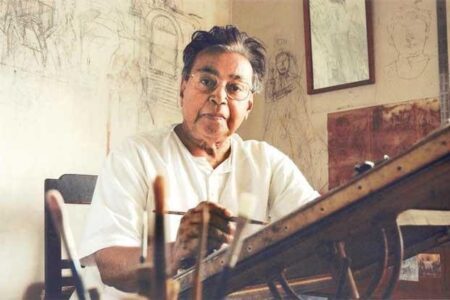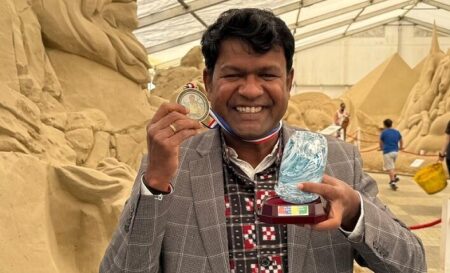An exhibition of photographs by Sudheesh Yezhuvath, Yours is Not to Reason Why: Tremors from Auschwitz, offers an eerily beautiful glimpse into a disturbing past.
“..the cry unuttered is the loudest”
A 19th-century Hasidic teacher
“Let us repeat it once again: Auschwitz is something else, always something else. It is a universe outside the universe, a creation that exists parallel to creation. Auschwitz lies on the other side of life and on the other side of death. There, one lives differently, one walks differently, one dreams differently.
“… the Holocaust is not a subject like all the others. It imposes certain limits.. In order not to betray the dead and humiliate the living, this particular subject demands a special sensibility, a different approach, a rigour strengthened by respect and reverence and, above all, faithfulness to memory.
“.. Today the question is not what to transmit, but how…Listen to the survivors and respect their wounded sensibility. Open yourselves to their scarred memory, and mingle your tears with theirs..”
Elie Wiesel – Art and the Holocaust: Trivializing Memory, June 11, 1989
The exhibition of photographs by Sudheesh Yezhuvath — Yours is Not to Reason Why — Tremors from Auschwitz – curated by Murali Cheeroth and Jayaraj Sundaresan on show at Durbar Hall Ernakulam from October 16 to 29 offers viewing experience of a different kind, both with regard to content and presentation.
These are photographs from the Auschwitz-Birkenau Memorial and Museum — of the towering, factory-like brick structures standing aloof amidst the serene, idyllic settings, the barbed wire electric fences, the rail tracks and wagons that carried millions to their death, the dark, ominous interiors of the gas chamber, the piles of rusted empty gas cans, the toilets, the wash, the furnace and the ash pit, the other exhibits in the museum like the huge heaps of torn and worn-out footwears of the prisoners, their briefcases with names and numbers written on them, the crutches and artificial limbs they left behind, their utensils and bedsheets, and the most haunting human presence — the long, unending rows of the photographs of the inmates staring blankly at us – what do they tell us?
Are they bleak remnants from the ruins of history, apparitions from the past or ominous warnings about the present and forebodings about the future?
What do they tell us? And why Auschwitz now?
Except for the built structures of the camp and its views from outside, all the other photographs are photographs of photographs that are exhibited in the museum. There is a curious kind of gaze at work here. They are not ‘original’ in any sense; many of these images are familiar to us through reproductions in books, articles and features on the holocaust. The interiors and gas chambers, the corridors and electric fences, the watchtowers and the slogan at the entrance ‘Arbeit macht frei’ (Work Sets You Free) — we have seen them all in umpteen Hollywood films and documentaries about Nazi terror.
So, what are these photographs telling us now? To a faraway viewer in Kerala or India?
Are they picture-notes of a traveller? Or is it a journey in time, and about an unforgettable encounter with a certain past? Can one look at the whole exhibition as a travelogue? Is it an effort to share with us the traveller’s own pain and horror in the face of such unbearable sight?
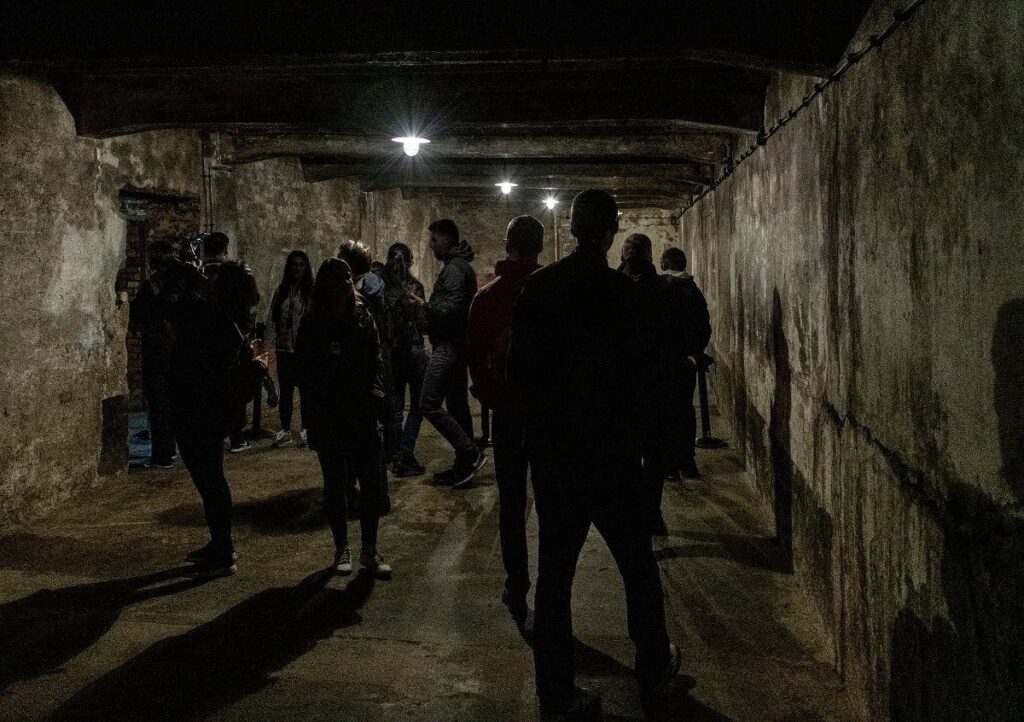
The Pictures
As one walks through the show, the distances from these pictures– of time, space and context – gradually seem to wear off. These desolate spaces, blank structures, bleak figures, orphaned objects and gloomy interiors begin to radiate ominous resonances and dark forebodings.
Looked at as museum objects, these pictures embody and represent ways in which a community, culture or nation remembers and memorializes a genocide that defies representation, whether it be in words and images, experiences or narratives, concepts and theories. This site and the objects there represent both the monstrosity of unimaginable horror as well as the banality of evil where ‘normal’ people like us — without any moral qualms or feelings of guilt — willingly became part of a machinery of death.
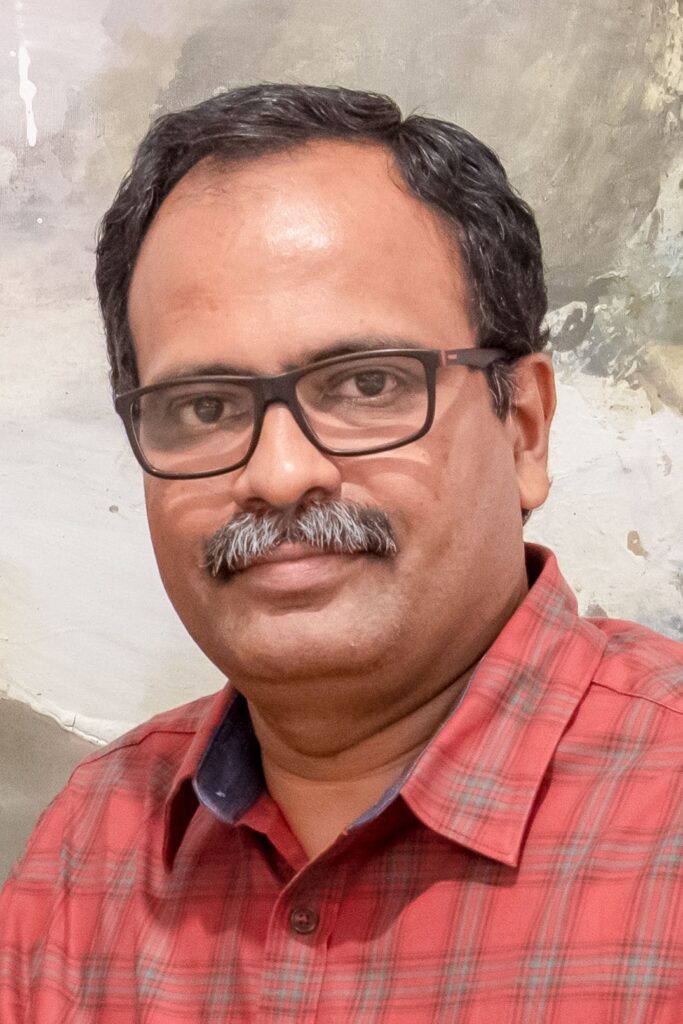
Sudheesh Yezhuvath
As Hannah Arendt, while reporting on Eichmann trial, chillingly reminds us, “The trouble with Eichmann was precisely that so many were like him, and that the many were neither perverted nor sadistic, that they were, and still are, terribly and terrifyingly normal. From the viewpoint of our legal institutions and of our moral standards of judgment, this normality was much more terrifying than all the atrocities put together, for it implied — as had been said at Nuremberg over and over again by the defendants and their counsels — that this new type of criminal, who is in actual fact hostis generis humani, commits his crimes under circumstances that make it well-nigh impossible for him to know or to feel that he is doing wrong.”
These images are testimonies as to how memories (and nightmares) persist, how they seep through time, loom over space and soak objects.
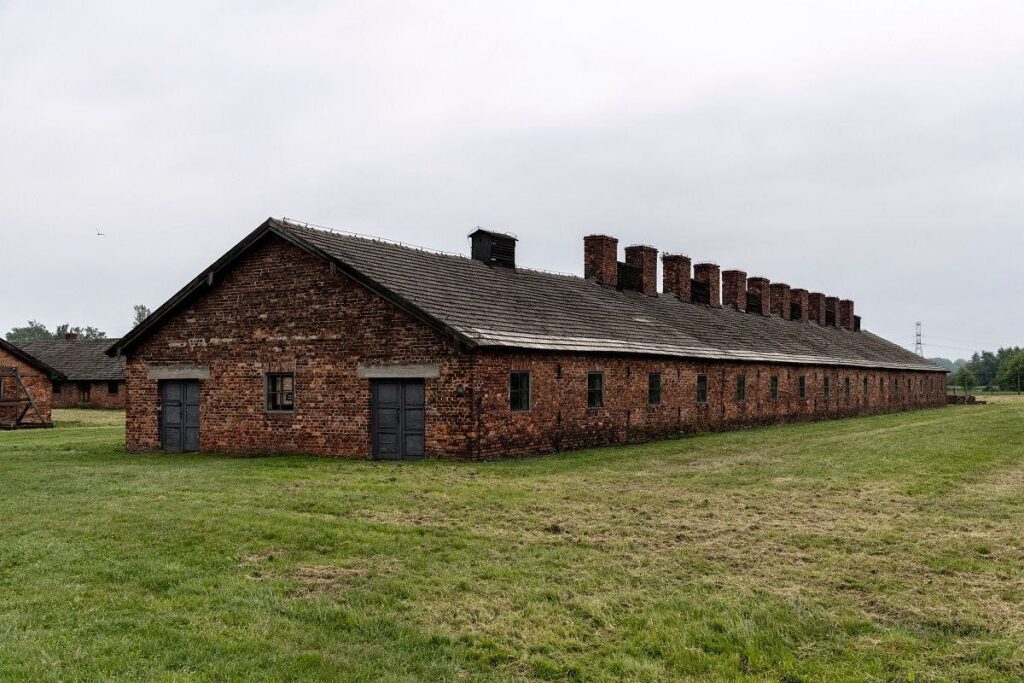
Numbers
Rather than titles, the photographs are marked by numbers. These are numbers generated by the photographing equipment itself, the camera, and so, has a certain randomness to them. It also gives the viewer an idea about the quantum of digital images from which the exhibited ones are chosen, indicating the work of the photographer and how the images are set free, as they were, and transmitted to us, the viewers, through a process of filtering, sorting and selection. On the other, the very sight of numbers has diabolic resonances in the context of concentration camps where prisoners are stripped not only of all possessions but also of all identities; they remain, survive, vegetate and finally march to the gas chambers as mere numbers.

Frames
Another interesting aspect of this exhibition is the way in which the images are framed, composed and displayed. As mentioned, they are photographs of photographs, and in many images, we can see the shadows, reflections, and the glass panes, frames and partitions which are part of the museum display. These incursions into and upon the ‘original’ image constantly remind us of the viewer who is viewing images and capturing it for us to view.
The reflection and shadow of the viewer who looks at the image, sometimes along with the others gazing beside him, place us almost along with them. We seem to gaze at the images over the photographer’s shoulders and along with others there. Suddenly, we join and become part of a spectral community — that of all the millions of viewers who have set their eyes on these images. In many cases, the glass partitions and frames also become part of the geometric composition of the photograph.
While the shadows and reflections add a vertical dimension to the viewing experience in terms of our frontal positioning in front of the image, a horizontal dimension is added by the composition of the image through the segmenting and division of/in its surface. It is a kind of spatial illusion or an illusionary space that also turns into illusionary time or a temporal illusion — of many temporalities that become present in viewing a picture of a picture being viewed – that resonates with the tremors of historical recurrences.
These shadows and reflections also have an ominous or uncanny presence within the frame: for instance, in the photographs of the narrow rooms that prisoners were shut in, we can see the reflection of the rows of photographs of the blank, staring faces of the prisoners from the opposite wall. These ghostly images from the realm of the dead seem to stare back at their past, and also at our present.
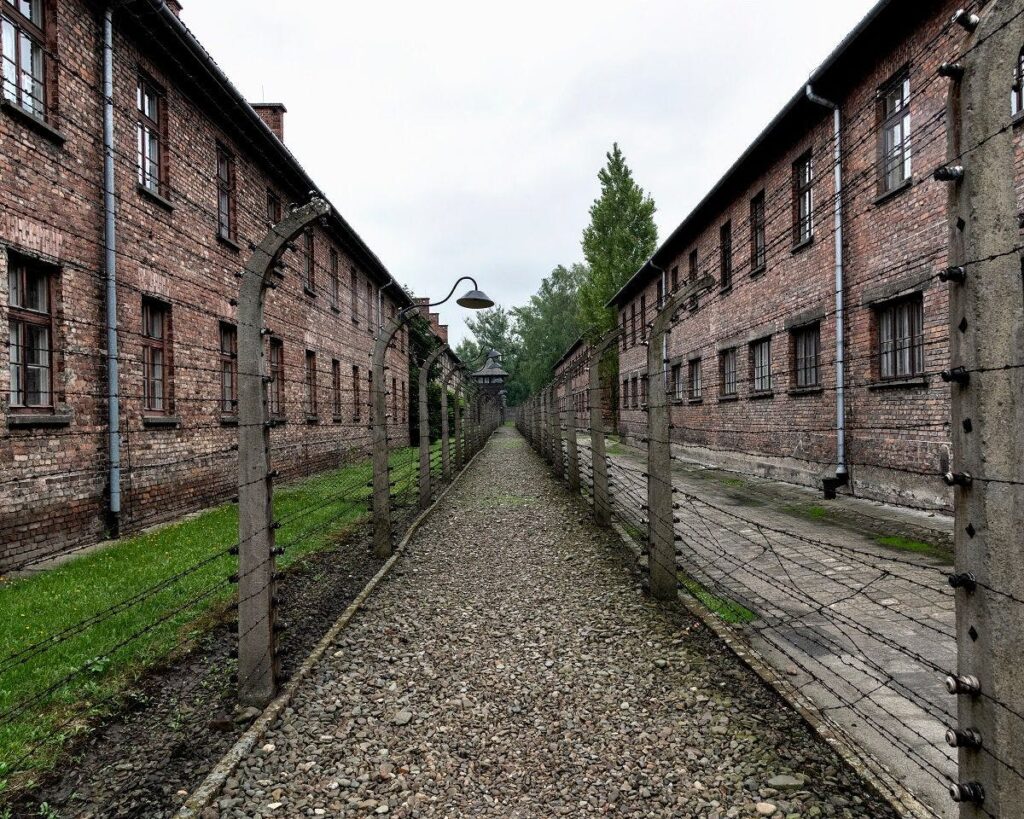
Display/design
These photographs – due to the gravity of the content and also the nature of capture — offer political and aesthetic challenges in terms of display and design. The curators have tried to break the painful monotony inherent to these images by varying their size and scale, and also through replication. Many of the photographs are replicated and hung together. Such replication repeats the replication process involved in the very nature of this show — which consists of images of images — and also brings into the viewers’ memory their endless reproductions in different modes and formats, mediums and surfaces.
It also resonates with the monotony of horror that was enacted there. Jean Cayrol, the poet who wrote the narration for Alain Resnais’ epic documentary Night and Fog, mentions the fossilized, repetitive time within which the prisoners in the camps lived: “..the appalling nature of what he had to endure, and that sudden revelation of a ‘timeless’ time, preserved and fossilized in his dreams, which eternalized his being, so to speak; he was tossed between the secrecy of his true human existence and the hellish replication of the concentration camp.”
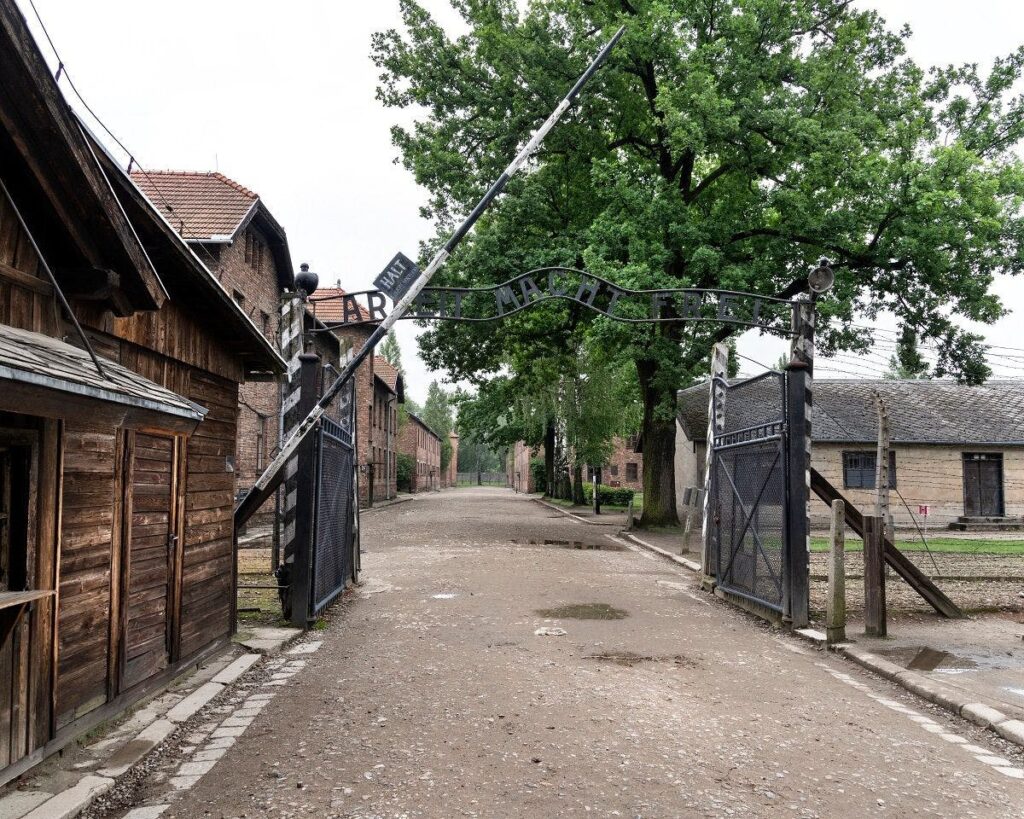
The display wall that is erected in the middle of the gallery, with its sharp angles and plain surface, also evokes the arid coldness and inhuman geometry of the concentration camp architecture. So do the books – the most poignant and heart-wrenching accounts that emerged from the site — that are hung from the ‘roofs’ of the miniature cavities built into the display wall.
One cannot escape the uncanny taste of horror and claustrophobia that these images of the now dysfunctional architecture, its cold interiors and remnants of the dead leave behind in our minds; all the more diabolic with the thickening shadows and forebodings of the calls for total closures and Final Solutions around us.


